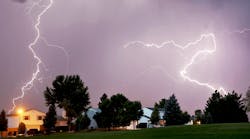Latest from Network Reliability/Testing & Assurance/Cybersecurity/Safety
Why Must We Ground?
A Loaded Question Is Answered
Metallic substances differ from all other materials because their outer shells possess loosely bonded electrons, while at the same time the interior of the metal contains a large number of un-bonded moving electrons. When this metal is attached to an electrical force, these electrons rush in the direction of the force, forming electric current. These same electrons always seek stability, which grounding helps provide.
We are all familiar with the requirement for grounding in North America. We understand its necessity, because of the requirement for a ground path in both Alternating Current Circuits (AC) as well as Direct Current Circuits (DC).
In the basic DC circuit diagram in Figure 1, we see the ground path protecting a battery and 2 appliances, indicated by the resistor symbol (R1) in the circuit path. If we short the circuit across the positive and negative feeds, we can see the ground implementing its protection. (See Figure 2.) Without it, the appliances could be damaged and cease to function and the battery could be depleted.
Figure 1. Direct Current Circuit
Figure 2. Direct Current Circuit (Shorted)
In the typical AC circuit shown in Figure 3, we see how the ground not only protects the appliances, but how the neutral path is also grounded. This is so it can carry off additional electrons from surges, capacitance build-out as well as electrons from EMF, and from the electronic circuits embedded in individual appliance circuit boards.
Figure 3. Typical Alternating Current (AC) circuit.
Three Reasons
Reason #1: When considering Lightning, no one disputes that the most important effort is to direct power from the strike to ground as soon as possible. This will safeguard operating systems as well as life and property. However, this is not the only reason for grounding electrical systems.
Reason #2: Electrical systems are subject to overvoltage conditions. Surges occur, along with unintentional contact with other circuits of higher voltage. These situations cause voltage introduction into electrical distribution systems. While grounding provides a path around electrical systems to limit damage, it also provides human safety. Inferred in this is the enabling of over-voltage and over-current Surge Protection Devices (SPD) to insure a safe outcome.
Reason #3: A third reason for grounding is Voltage Stabilization. In grounding, we know the earth is a reservoir for electrons, and they will always seek to return to this point, because it is the point of lowest potential. Meanwhile, there are multiple sources of electricity. To understand the relationship between these multiple sources, we need to be able to measure and quantify the amount, type, and strength of their electron flow. Because an earth/ground in North America has no power on it, and is the most ubiquitous conductor, it can reliably serve as the baseline or reference point for these evaluations.
At this point, let’s review. Electron "flow" is not a flow like a stream of water. Instead, it’s a "bumping" of electrons along a conducting path. This "bumping" movement can "flow" at the speed of light, or 186,000 miles/second. In addition, this "bumping flow" of electrons can induce electron flow in adjacent conductive paths, because "lines-of-force" that emanate from the conductive path, as you learned in your high school physics class, cut across adjacent conductive paths, inducing corresponding electron "flows" in those at the same time.
Because of these phenomena, we know the electron world as a multifaceted environment that ebbs and flows, continually expanding and contracting, but always requiring a return path to the electronic origin of the initial "flow". For example, in DC we have an outbound negative path returning by the positive path. That return path can be provided by a separate wire connection or by a conductive path through the earth. Depending upon which country you are in, this return path may be called "earth" or "ground" as they are one in the same.
In the 1860s, early telegraph system return paths were often routed through the earth. Later, a ground return path was developed through a separate wire, because using the earth over long distances proved unreliable due to conductive variations in soil resistance.
The use of the earth/ground in Europe is different when compared to North America. In North America, our National Electric Code (NEC) requires a separate ground path to protect equipment and systems as well as to provide human safety. This path specifically contains no power on the circuit. In Europe, the practice of bonding the return or positive conductor to the ground conductor is an accepted practice and considered as safe as the North American separate conductor path to ground. The difference is that the European bonded return carries the return power current and the separate North American Ground Path carries no power at all. It should be pointed out that European Systems purchased for installation in North America must be modified with a separate path to ground, or they will not be allowed to be installed, often by the local permitting office. To do so would contaminate local grounding systems with unwanted power.
Besides the differences between the European and North American Grounding procedures, another example addresses the differences between the Radio Frequency (RF) Ground and Direct Current (DC) Power Ground.
Basically, in the RF Ground, electrons "flow" over the ground conductor’s outer surface, often referred to as "Skin-Effect". This is because the RF wavelength is too short to penetrate a solid copper wire path. The electrons in a Power Ground, where the frequency wavelength is much longer, "flow" through the ground conductor. It is this frequency difference that causes the electrons to "flow" in different ways. The shorter the frequency wavelength, the less likely it is to penetrate a large cross-section of solid or stranded copper cabling. Nevertheless, the surface area and the cross-section of the ground conductor in both cases must have the same conductor area in circular mils to properly function as a ground conductor depending on the frequency of the current being grounded.
Getting Grounded
Confusion has resulted in the use of the outer corrugated or armored conductor used to encase multiple power conductors in a typical Hybrid Cable. It’s fine when the outer conductor of a Coaxial Feeder is transmitting Radio Frequency Energy. However, the outer conductor, when used in a Hybrid Cable, cannot equate to the required circular mils of total copper cross-section contained within the multiple power cables carried inside the corrugated outer shell. Consequently, this type of ground would be inadequate to properly ground included power cables. In addition, these multiple power cables often store Capacitive Inductance caused by the fluctuations in power demand by users’ cell phones. Without adequate ground, this capacitance cannot be directed to ground and sometimes affects adjacent systems.
Finally, grounding must be configured using the same low resistance metals. Mixing metals between power and ground is prohibited by the NEC. For example, if you connect copper and aluminum together in a grounding configuration; the aluminum and copper, being dissimilar metals, and the aluminum being the secondary metal, besides increasing the resistance in the ground path, will corrode and disintegrate over time.
Be aware, the resistivity of metals is crucial to creating a least-resistive path to ground. Electrical resistivity is a measure of how strongly a material opposes the "flow" of electric current and is commonly measured in Ohms/meter of distance. For example, in metals with the same cross-section the resistivity of Aluminum is 2.82e-8. The resistivity of Copper is 1.68e-8. So, by mixing these 2 metals, we increase the electrical resistance of the ground path when the objective is to create a least resistive path to ground.
So, let us take a look at the original question again: Why must we connect electrical systems to ground? There are 3 reasons:
Reason #1: To protect human life, critical electrical systems and components.
Reason #2: To provide protection from surges by enabling activation of voltage and/or current Surge Protection Devices.
Reason #3: To provide a safe and reliable, no power reference point, for measurement and evaluation, to promote understanding associations between different electrical systems, circuits, and configurations.




